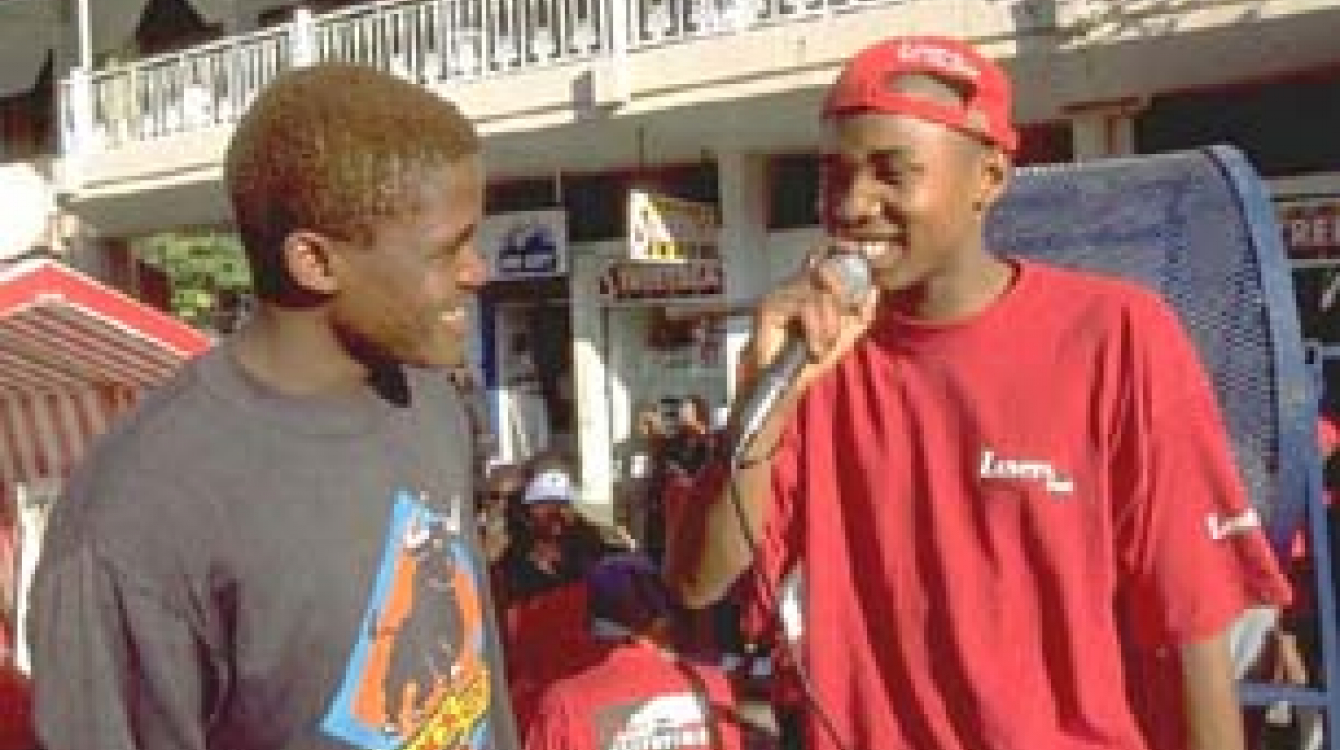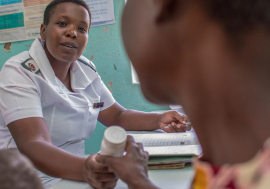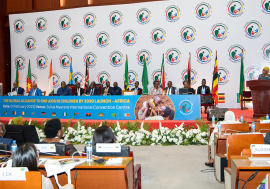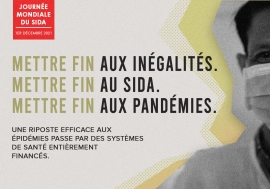Botswana's high-stakes assault on AIDS
Botswana's high-stakes assault on AIDS
The gleaming floors, white-frocked technicians and humming electronic equipment of the Botswana-Harvard HIV Reference Laboratory here in Botswana's capital are distant in more ways than geography from the dusty villages and crowded mining compounds on the frontline of Botswana's desperate struggle against HIV/AIDS. But closing the gap between the resources available at this modern new facility, and the nearly 40 per cent of the adult population infected with the deadly virus, is at the heart of Botswana's high-stakes effort to provide comprehensive HIV/AIDS treatment to all of its citizens. In January, Botswana became the first country in Africa to offer expensive, but life-saving, anti-retroviral drugs (ARVs) and other medications to all who need them through the public health system.
It is a costly and ambitious undertaking, one that many health care experts say cannot be done in Africa. But for the 330,000 Botswanan adults estimated to be HIV-positive, access to ARVs and to ongoing care, counselling and testing, is a matter of life or death. The vast but sparsely-populated territory has the highest HIV infection rate in the world (see table, below). Some 26,000 people in this country of less than 1.6 million died from AIDS-related illnesses last year alone. "We are threatened with extinction," President Festus Mogae told the UN General Assembly last year. "People are dying in chillingly high numbers. It is a crisis of the first magnitude."
More than Botswanan lives may be at stake, however. For years, some international health experts, backed by many donor governments and agencies and the powerful pharmaceutical industry, have argued that poverty and the absence of infrastructure make it impossible to successfully treat large numbers of HIV-positive people in developing countries with AIDS medications. Rather than waste resources on a failed effort to treat those already ill, they assert, scarce funds should be spent preventing new infections through education and prevention programmes.
Activists counter that pilot projects have demonstrated the feasibility of treatment programmes in developing countries, and that only a combination of treatment and prevention can turn the tide against the disease. Many advocates charge that opposition to large-scale treatment programmes is fueled more by concerns for patent rights and profits than genuine doubts about practicability.
Botswana's AIDS epidemic, 2001
Population
1.6 million
Adult population (15-49)
762,000
Total adults with HIV
300,000
Adult infection rate
38.8 %
Adult women with HIV
170,000
Adult men with HIV
130,000
Children with HIV (0-14)
28,000
Older adults with HIV (50+)
2,000
Total deaths (2001)
26,000
AIDS orphans (0-14)
69,000
Life expectancy (1987)
63
Projected life expectancy (2005)
37
Source: UN Africa Recovery from UNAIDS, World Bank data
Botswana is the first African test case. Success in treating large numbers of patients will buttress the argument for greatly expanded treatment efforts in the rest of Africa and other developing regions. Failure will badly undermine the call for greater treatment access for the world's poor. Although the Joint UN Programme on HIV/AIDS (UNAIDS) has long maintained that both prevention and treatment are necessary in the campaign against AIDS, fewer than 30,000 of the almost 29 million Africans infected with the virus have access to the ARV drugs that have dramatically reduced death rates in rich countries (see "A grim prognosis for AIDS in Africa").
Slow but steady progress
If any country in sub-Saharan Africa can implement a comprehensive HIV/AIDS prevention care and treatment programme, observers say, it is Botswana. Unlike many of its neighbours, the country has enjoyed an unbroken period of peace and comparative prosperity since independence in 1966. Its government is widely regarded as among the most efficient and capable on the continent, and its annual per capita income of $3,300 is among the highest.
Still, the obstacles are formidable. Many Botswanans are migrant workers, employed in neighbouring South Africa for much of the year, but maintaining farms and families back home. Migrants are at particular risk of infection because of the increased likelihood of contact with prostitutes and other casual sex partners while away from home. Often unaware that they have become HIV-positive, and unwilling to seek out testing and counselling because of the stigma associated with the disease, migrants are thought to be an important factor in the spread of the virus.
For those who do seek medical help, there is the problem of locating it. For HIV patients outside the private sector, there are only two government referral hospitals, one in Gaborone and another in the north, in Francistown. There are two smaller, district hospitals in the country, but most public health care is delivered through local clinics offering only basic services.
The National AIDS Coordinating Agency (NACA) formally embarked on the national treatment programme in January this year. Dr. Banu Khan, NACA's national AIDS coordinator, told Africa Recovery that the government set a target of 19,000 people for enrolment in their first year of ARV treatment under a $27.5 mn programme in which people who require the drugs will get them for life. The ministry of health has calculated the cost of medications, testing and counselling at about $600 per person, per year. Over the first five years of the programme, the Gates Foundation will provide $50 mn to help Botswana strengthen its primary health care system, while the giant US drug manufacturer Merck will match that contribution with anti-retroviral medicines. The other half of the cost, some $100 mn, will be met by the government.
Success in treating large numbers of patients will buttress the argument for greatly expanded treatment efforts in the rest of Africa and other developing regions.
"As of June this year, we had an estimated 1,000 people enrolled," Dr. Khan noted. "We have 500 undergoing the treatment, while the remainder are still being screened to ascertain their precise treatment requirements." She termed that number "disappointingly" low, but said that more people are steadily coming forward. NACA says the volunteer patients include a "good mix" of educated and poorer rural people, some from the remote regions of the arid Kalahari in the west and northwest of the country.
Significantly, NACA officials say, initial indications are that very few patients have difficulty adhering to the complex ARV drug treatment regimes. The ability of poor and poorly educated patients to stick to strict medication schedules over a lifetime has been a major concern of health specialists and is an important aspect of Botswana's treatment initiative. Like Alcoholics Anonymous, NACA operates a "buddy system" whereby each patient is encouraged to form a special bond with someone close, who makes sure they remain on their medication schedule. The patients, in turn, counsel others who feel they may need help, to come forward.
Targeting mothers
Enrolling women in the programme is a key priority because they make up more than half of all infected adults. Dr. Khan said that NACA is especially concerned at the low intake of mothers in a programme intended to cut mother-to-child transmission of the HIV virus and keep infected mothers alive. Since the pilot project began, she said, only 2,000 women are currently undergoing treatment for AIDS-related illnesses. "We only opened up pilot sites two years ago. The percentage of mothers enrolled, however, is not desirable. It is low and must be increased. We have problems here, especially the one of stigma." Health officials said enrolment by pregnant mothers had only been in the 11-20 per cent range.
"Another problem is the status of women in relation to men," Dr. Khan added. Many women lack the power to control decisions about sexuality and remain under the authority of husbands, parents and in-laws all their lives. "How do you test someone if they do not get permission?", Dr. Khan asked.
"Then, with those who do enrol, they go home to a remote village with formula milk for their baby and are branded as suspect because they are not breast-feeding.... Mothers also worry about who will look after their baby if they die. But ARV therapy is now available in Botswana for these mothers and their babies, and I am hoping [enrolment] will increase now."
The country currently has 16 voluntary counselling and testing centres specifically for mothers, one in every district. These are stand-alone centres where one can discuss medical problems in privacy. "For example, in the latter part of last year, we had a conference for people living with HIV/AIDS and it drew 500 sufferers," Dr. Khan noted. "They went back to their homes and formed support groups to reduce stigma."
Botswana is supporting the new drug treatment policy with an expanded and more aggressive education campaign, modeled in part after Uganda.
Dr. Khan said that NACA urgently needs more trained staff. "We have found that if you have a trained nurse dealing with many people in a rural clinic, for example, she does not have the time to counsel every HIV patient. So we are building a system of lay counselors, like social workers. For this, we do not necessarily need nurses and we have a programme to employ 500 such lay counselors. We are hoping they will also play a key role in reducing stigma."
She said that people living with AIDS, both from the educated urban classes and rural communities, are increasingly aware that the government is providing free lifelong treatment. "These people are with us on a voluntary basis. No one is coerced. We counsel them on positive living, about prevention, about the importance of remaining on the treatment even if they feel better. And they usually go home and spread this positive message."
Staff shortages severe
At present, NACA employs 10 doctors working full time on HIV/AIDS at the Princess Marina Hospital in Gaborone, and five at each of the other hospitals. Patients are also seen at the smaller health facilities, some of them mobile clinics, around the country. Uniquely for an African country, NACA says, almost no one is more than 8 km away from a clinic where they can seek medical help. Even in the remotest areas of the Kalahari, most people are just 15 km away. These clinics decide what sort of treatment people need, and either refer them to a hospital or provide them with ambulance transport if required.
Ms. Catherine Sozi, a British-trained Ugandan doctor based at the UNAIDS office in Pretoria, South Africa, said Botswana can sustain its national health scheme for AIDS patients even though the drugs are required for life. "However, there is an acute, absolute shortage of doctors, nurses and counselors in Botswana's health care system," she said, citing a recent UNAIDS assessment. "Although we did not have time to calculate the number of extra health workers needed for the ARV programme, the numbers are substantial. If a first recruitment for ARV treatment would cost one hour of a doctor's time, recruiting 10,000 new patients in three months, for example, would require at least 20 fulltime doctors doing nothing else but supervising these patients."
The shortage of doctors, pharmacists, nurses and counselors is compounded by the fact that over 90 per cent of doctors in Botswana are foreigners who do not speak Setswana. Counselors too are recruited from abroad and need to spend time becoming familiar with the local culture. Many spend only a brief period in the country, thus exacerbating the need for frequent training and supervision to ensure proper medical care. There also is concern that many nurses, once trained and registered, emigrate to better-paid jobs abroad.
The government is seeking to recruit up to 200 new doctors from South Africa, Cuba and other nations to administer the drug programme. "In return for their travel and accommodation expenses, many are coming to give their time free of charge," Dr. Khan explained. "They know the government is serious in addressing this epidemic."
The shortage of pharmacists outside the major hospitals is another problem. UNAIDS found that Botswana's few pharmacy technicians already have to manage drug supplies and distribution in the hospital and surrounding clinics. "They need support if they are to handle sensitive drugs like ARVs," Dr. Sozi said. Because Botswana will have to rely for some years to come on foreign health professionals, she noted, UNAIDS is recommending appropriate courses for them about local culture, health policies and protocols. Many current staff will require crash courses on ARV treatment issues.
Testing, monitoring and surveillance of the Botswana AIDS plague, as many now call it, is carried out by the new Botswana-Harvard laboratory at the Princess Marina Hospital. The first of its kind anywhere in Africa, the laboratory, with a staff of 50, is equipped with gene sequencers and blood cell sorters, enabling scientists to keep track of the spread of HIV, especially the HIV-1C strain prevalent in Africa.
The lab will also conduct research for the development of new medicines, including a vaccine. "The virus strain in Botswana is clearly different from those we see in the West," said Dr. Max Essex, Chair of the Harvard AIDS Institute. "Nobody knows if a vaccine [being developed] against HIV-1B, the strain most common in Europe and the US, will work as well against HIV-1C." Scientists at the institute said they are concerned that strains like HIV-1C would become even more drug resistant without effective monitoring of patients taking ARVs. This is why, Dr. Khan said, the "buddy" system to ensure adherence is as important a component in the battle as further funds for training new medical teams.
Combining treatment and prevention
Botswana is supporting the new drug treatment policy with an expanded and more aggressive education campaign, modeled in part after Uganda, which has successfully reduced new HIV infections through sustained public education. President Mogae is determined to make sure that the message of free treatment gets out -- through radio, billboard campaigns and by word of mouth.

Young Botswanan activists have been key in public AIDS education and prevention programmes.
Photo : ©UNAIDS / G. Pirozzi
Mr. Edmund Dladla, national coordinator of the Botswana Network of People Living With HIV/AIDS, welcomed the president's leadership. "Any person who is of working age, who has a job and some education talks about it. And everyone wonders about the impact AIDS is having, not only on those close to them, but also on the country as a whole. People are scared."
"For a decade," he continued, "until the end of the 1990s, we were in a state of denial, blaming the crisis on foreigners. Then, as we realized its extent, we started acting. Today, I would say the government is very transparent, pro-active and accountable. We are the most advanced African nation in this struggle -- and believe me, I would not have said that just three years ago."
Employers get involved
Botswana's private sector has also become involved. Three years ago, the country's biggest employer, the Debswana diamond mining company, realized after testing its 6,000-strong workforce that fully a third of workers aged between 24 and 40 were HIV-positive. With revenues of some $1.8 bn dollars a year, and skilled miners scarce, the company set up its own HIV/AIDS scheme.
"We realized we had to do something fast because diamonds are the foundation of our economy," said Ms. Tsetsele Fantan, director of the company's programme. She said Debswana agreed to provide free treatment for each infected employee and one legal spouse, while the government would provide treatment for other partners and their children. The government has also urged major banks, transport companies and even petrol stations to provide better levels of health care and make HIV counselling and treatment available to their employees.
The Harvard-Botswana lab is another example of the public-private partnerships the Botswana government is seeking to build. The government provided $3 mn, while additional funding was contributed by the Gates and Merck Foundations, the Bristol-Myers Squibb drug company, the Harvard AIDS Institute and others.
"This collaborative programme is designed to demonstrate the benefits of a comprehensive, multi-sectoral approach to improving the care of people living with HIV in a country with limited resources," said Dr. Clement Chela, of the Botswana Comprehensive HIV/AIDS Partnership. The fact that ARVs are now freely available, he added, has become a motivating factor for people to come forward. "The programme we have put in place here can work in other countries in Africa, and with international financial help, it can be sustained."






















